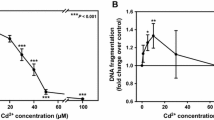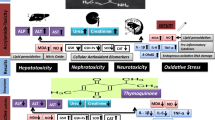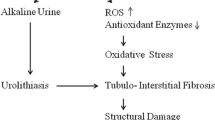Abstract
The effects of Hg(II) on bioenergetic and oxidative status of rat renal cortex mitochondria were evaluated both in vitro, and in vivo 1 and 24 h after treatment of animals with 5 mg HgCl2/kg ip. The parameters assessed were mitochondrial respiration, ATP synthesis and hydrolysis, glutathione content, lipid peroxidation, protein oxidation, and activity of antioxidant enzymes. At low concentration (5 µM) and during a short incubation time, Hg(II) uncoupled oxidative phosphorylation while at slightly higher concentration or longer incubation time the ion impaired the respiratory chain. The rate of ATP synthesis and the phosphorylation potential of mitochondria were depressed, although inhibition of ATP synthesis did not exceed 50%. In vivo, respiration and ATP synthesis were not affected 1 h post-treatment, but were markedly depressed 24 h later. ATP hydrolysis by submitochondrial particle FoF1-ATPase was inhibited (also by no more than 50%) both in vitro, and in vivo 1 and 24 h post-treatment. Hg(II) induced maximum ATPase inhibition at about 1 uM concentration but did not have a strong inhibitory effect in the presence of Triton X-100. Oxidative stress was not observed in mitochondria 1 h post-treatment. However, 24 h later Hg(II) reduced the GSH/GSSG ratio and increased mitochondrial lipid peroxidation and protein oxidation, as well as inhibited GSH-peroxidase and GSSG-reductase activities. These results suggest that the following sequence of events may be involved in Hg(II) toxicity in the kidney: (1) inhibition of FoFl-ATPase, (2) uncoupling of oxidative phosphorylation, (3) oxidative stress-associated impairment of the respiratory chain, and (4) inhibition of ATP synthesis.
Similar content being viewed by others
References
Zalups RK, Lash LH: Advances in understanding the renal transport and toxicity of mercury. J Toxicol Environ Health 42: 1–44, 1994
Stohs SJ, Bagchi D: Oxidative mechanisms in the toxicity of metal ions. Free Rad Biol Med 18: 321–336, 1995
Nath KA, Croatt AJ, Likely S, Behrens TW, Warden D: Renal oxidant injury and oxidant response induced by mercury. Kidney Int 50: 1032–1043, 1996
Weinberg JM, Harding PG, Humes HD: Mitochondrial bioenergetics during the initiation of mercuric chloride-induced renal injury. I. Direct effects of in vitro mercuric chloride on renal cortical mitochondrial function. J Biol Chem 257: 60–67, 1982
Weinberg JM, Harding PG, Humes HD: Mitochondrial bioenergetics during the initiation of mercuric chloride-induced renal injury. II. Functional alterations of renal cortical mitochondria isolated after mercuric chloride treatment. J Biol Chem 257: 68–74, 1982
Lund B, Miller DM, Woods JS: Mercury-induced H2 O2 production and lipid-oxidation in vitro in rat kidney mitochondria. Biochem Pharmacol 42: S181–S187, 1991
Lund B, Miller DM, Woods JS: Studies on Hg(II)-induced H 2 O 2 formation and oxidative stress in vivo and in vitro in rat kidney mitochondria. Biochem Pharmacol 45: 2017–2024, 1993
Girardi G, Elías MM: Mercuric chloride effects on rat renal redox enzymes activities: SOD protection. Free Rad Biol Med 18: 61–66, 1995
Uyemura SA, Curti C: Steady-state kinetic properties of FoF1-ATPase: the pH effect. Int J Biochem 24: 1743–1748, 1992
Bradford MM: A rapid sensitive method for the quantification of microgram quantities of protein utilizing the principle of protein-dye binding. Anal Biochem 72: 248–254, 1976
Chance B, Williams GR: The respiratory chain and oxidative phosphorylation. Adv Enzymol 17: 65–134, 1956
Cain K, Skilleter DN: Preparation and use of mitochondria in toxicological research. In: K Snell, B Mullock (eds). Biochemical Toxicology. IRL Press, Oxford, 1987, pp 217–254
Lemasters JJ, Hackenbrock CR: Continuous measurement and rapid kinetics of ATP synthesis in rat liver mitochondria, mitoplasts and inner membrane vesicles determined by firefly-luciferase luminescence. Eur J Biochem 67: 1–10, 1976
Slater EC, Rosing J, Mol A: The phosphorylation potential generated by respiring mitochondria. Biochim Biophys Acta 292: 534–553, 1973
Heinonen JD, Lahti RJ: A new and convenient colorimetric determination of inorganic orthophosphate and its application to assay of inorganic pyrophosphatase. Anal Biochem 113: 313–317, 1981
Leone FA, Degreve L, Baranauskas JA: SIGRAF: A versatile computer program for fitting enzyme kinetic data. Biochem Educ 20: 94–96, 1992
Tietze F: Enzymic method for quantitative determination of nanogram amounts of total and oxidized glutathione: Applications to mammalian blood and other tissues. Anal Biochem 27: 502–522, 1969
Buege JA, Aust SD: Microsomal lipid peroxidation. Meth Enzymol 52: 302–310, 1978
Levine RL, Garland D, Oliver CN, Amici A, Climent I, Lenz AG, Ahn BW, Shaltiel S, Stadtman ER: Determination of carbonyl content in oxidatively modified proteins. Meth Enzymol 186: 464–478, 1990
Lawrence RA, Burk RF: Glutathione peroxidase activity in selenium deficient rat liver. Biochem Biophys Res Commun 71: 952–958, 1976
Carlberg I, Mannervik B: Purification and characterization of the flavoenzyme glutathione reductase from rat liver. J Biol Chem 250: 5475–5480, 1975
Chávez E, Holguín JA: Mitochondrial calcium release as induced by Hg2+. J Biol Chem 263: 3582–3587, 1988
Chávez E, Zazueta C, Osornio A, Holguín JA, Miranda ME: Protective behavior of captopril on Hg2+-induced toxicity on kidney mitochondria. In vivo and in vitro experiments. J Pharmacol Exp Ther 256: 385–390, 1991
Souza MEJ, Polizello ACM, Uyemura SA, Castro-Silva O Jr, Curti C: Effect of fluoxetine on rat liver mitochondria. Biochem Pharmacol 48: 535–541, 1994
Yagi T, Hatefi Y: Thiols in oxidative phosphorylation: Thiols in the Fo of ATP synthase essential for ATPase activity. Arch Biochem Biophys 254: 102–109, 1987
Canton M, Gennari F, Luvisetto S, Azzone GF: The nature of uncoupling by n-hexane, 1-hexanethiol and 1-hexanol in rat liver mitochondria. Biochim Biophys Acta 1274: 39–47, 1996
Sone N, Larsstuvold K, Kagawa Y: Effect of methyl mercury on phosphorylation, transport, and oxidation in mammalian mitochondria. J Biochem (Tokyo) 82: 859–868, 1977
Chance B, Sies H, Boveris A: Hydroperoxide metabolism in mammalian organs. Physiol Rev 59: 527–605, 1979
Ambrosio G, Zweier JL, Duilio C, Kuppusamy P, Santoro G, Elia PP, Tritto I, Cirillo P, Condorelli M, Chiariello M, Flaherty JT: Evidence that mitochondrial respiration is a source of potentially toxic oxygen free radicals in intact rabbit hearts subjected to ischemia and reflow. J Biol Chem 268: 18532–18541, 1993
Zhang Y, Marcillat O, Giulivi C, Ernster L, Davies KJA: The oxidative inactivation of mitochondrial electron transport chain components and ATPase. J Biol Chem 265: 16330–16336, 1990
Goldstein RS: Biochemical heterogeneity and site-specific tubular injury. In: JB Hook, RS Goldstein (eds). Toxicology of the Kidney. Raven Press, New York, 1993, pp 201–248
Brand MD: The proton leak across mitochondrial inner membrane. Biochim Biophys Acta 1018: 128–133, 1990
Author information
Authors and Affiliations
Rights and permissions
About this article
Cite this article
Uyemura, S.A., Santos, N.A., Mingatto, F.E. et al. Hg(II)-induced renal cytotoxicity: In vitro and in vivo implications for the bioenergetic and oxidative status of mitochondria. Mol Cell Biochem 177, 53–59 (1997). https://doi.org/10.1023/A:1006861319378
Issue Date:
DOI: https://doi.org/10.1023/A:1006861319378




